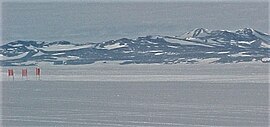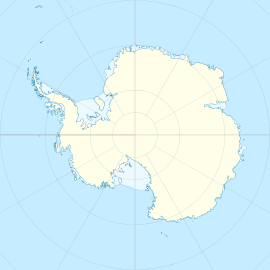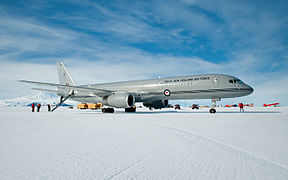avia.wikisort.org - Aerodrome
Pegasus Field (ICAO: NZPG) was an airstrip in Antarctica, the southernmost of three airfields serving McMurdo Station. It closed due to excessive melting in the summer season caused by warmer temperatures combined with dust and dirt blown in from nearby Black Island. The last flight was on December 8, 2016[4] and it was replaced by Phoenix Airfield (ICAO: NZFX)[5][6][7] with flights expected to start in February 2017.[6]
Pegasus Field | |||||||||||||||
|---|---|---|---|---|---|---|---|---|---|---|---|---|---|---|---|
 White ice runway at Pegasus Field | |||||||||||||||
| |||||||||||||||
| Summary | |||||||||||||||
| Location | McMurdo Station, Ross Island, Antarctica | ||||||||||||||
| Elevation AMSL | 18 ft / 5 m | ||||||||||||||
| Coordinates | 77°57′48″S 166°31′28″E | ||||||||||||||
| Map | |||||||||||||||
 NZPG Location of airfield in Antarctica | |||||||||||||||
| Runways | |||||||||||||||
| |||||||||||||||
Pegasus was originally conceived as a blue ice runway capable of handling wheeled aircraft year-round, but as it was developed, it was enhanced with a 4-inch layer of compacted snow on top—thus more properly characterizing it as a white ice runway. [8] Other local runways are the snow runways at Williams Field (ICAO: NZWD) that are limited to ski-equipped aircraft, and the Ice Runway (ICAO: NZIR) on the sea-ice available during the summer Antarctic field season.
The field is named after Pegasus, a C-121 Lockheed Constellation that made a forced landing on unprepared terrain in bad weather on October 8, 1970. None of the 80 on board were seriously injured. The aircraft remains in-situ near the airfield as of 2019, and has remained well preserved. It is generally covered with snow, but is occasionally excavated by visitors wishing to photograph it.[9]
On September 11, 2008, a United States Air Force C-17 Globemaster III successfully completed the first landing in Antarctica using night-vision goggles at Pegasus Field.[10] Previously air transport in the permanent darkness of the winter was only used in emergencies, with burning barrels of fuel to outline the runway.
Gallery
- United States Air Force C-5 Galaxy being off-loaded at Pegasus Field.
- RNZAF Boeing 757 lands at Pegasus Airfield on the Ross Ice Shelf during its maiden flight to Antarctica.
See also
References
- "Airport information for NZPG". World Aero Data. Archived from the original on 2019-03-05.
{{cite web}}: CS1 maint: unfit URL (link) Data current as of October 2006. Source: DAFIF. - Airport information for NZPG at Great Circle Mapper. Source: DAFIF (effective October 2006).
- USAP.gov US Antarctic Program Inter-agency Air Operations Manual
- NZDF Airlift Missions Renew Lifeline For Scientists In Antarctica Archived 2017-01-06 at the Wayback Machine
- "NZFX - McMurdo Station [Phoenix Field], Ross Island, AQ - Airport - Great Circle Mapper".
- US Antarctic Program Inter-agency Air Operations Manual – United States Antarctic Program
- "A New Runway for McMurdo Station is Named". National Science Foundation. 7 April 2016.
- Wallwork, Ellery D. (October 2006). "Operation Deep Freeze—50 Years of Air Force Airlift in Antarctica 1956–2006 (page 265)" (PDF). Archived from the original (PDF) on 2016-05-07.
- Pegasus Wreck - Atlas Obscura - Accessed upon September 16, 2019
- Rejcek, Peter (September 26, 2008). "Air Force successfully tests new capability to fly any time of year to McMurdo". Antarctic Sun.
External links
- Airfields on Antarctic Glacier Ice Malcolm Mellor and Charles Swithinbank, CRREL 1989.
- Lockheed Aircraft R7V-1 / R7V-1P / C-121J "Constellation" "Connie"
- Installation of runway-Pegasus
- Runway Project Clears the Way for Improved Antarctic Airlift National Science Foundation. February 20, 2002.
- Construction, Maintenance, and Operation of a Glacial Runway, McMurdo Station, Antarctica George L. Blaisdell et al., CRREL Monograph 98–1, March 1998.
- Current weather for NZPG at NOAA/NWS
На других языках
[de] Pegasus Field
Pegasus Field (ICAO: NZPG) auf dem Ross-Schelfeis war der südlichste der Flugplätze der sieben Seemeilen nördlich gelegenen McMurdo-Station in der Antarktis. Die rund 3050 Meter lange und 45 Meter breite Start- und Landebahn lag auf 5 Metern Meereshöhe auf einem Blaueisfeld, bestand aus Eis und konnte ganzjährig von Flugzeugen mit Fahrwerken benützt werden.[2] Bei den anderen beiden Flugplätzen handelt es sich um Williams Field (ICAO: NZWD), dessen Schnee-Start- und Landebahn nur mit Kufen ausgerüstete Flugzeuge anfliegen können, sowie Ice Runway (ICAO: NZIR) auf dem vorgelagerten Meereis, das nur während des antarktischen Sommers verfügbar ist.- [en] Pegasus Field
[fr] Pegasus Field
Pegasus Field (code OACI : NZPG), est la plus australe des trois pistes d'atterrissage de la base antarctique McMurdo. Cette piste de glace blanche terminé en 1992 est utilisée par les appareils à roues qui ne peuvent pas atterrir sur la piste de Williams Field, plus fréquentée et faite de neige donc nécessitant des skis, jusqu'à un ultime vol le 8 décembre 2016. Elle est remplacée par Phoenix Airfield (en).Другой контент может иметь иную лицензию. Перед использованием материалов сайта WikiSort.org внимательно изучите правила лицензирования конкретных элементов наполнения сайта.
WikiSort.org - проект по пересортировке и дополнению контента Википедии

